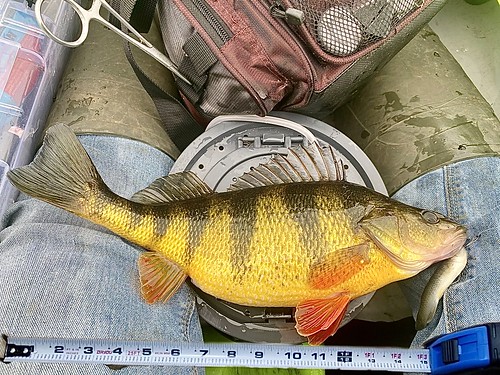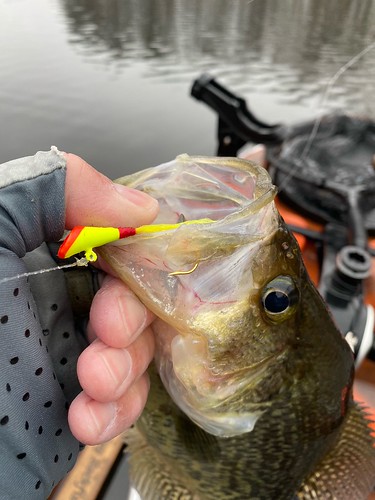Maryland Fishing Report – March 10

Photo by Montana Grant
Warmer weather has everyone thinking about getting outdoors, and fishing is often at the top of the list. The yellow perch spawning runs are starting in the upper sections of a number of tidal rivers, and this weekend is a wonderful time for everyone to get in on the action.
The Maryland Department of Natural Resources is recruiting participants for the shad volunteer angler survey. This brief online survey is smartphone compatible and provides valuable information for the restoration of these prized fish. Anglers are invited to log their shad fishing trips, even if you don’t catch any shad.
Also, please join us on March 11 at noon for a Maryland Fishing Roundtable webinar on the Maryland Artificial Reef Initiative, known as MARI. Coordinator Mike Malpezzi will discuss Maryland’s artificial reef program and its importance for the angling community. Details for joining the webinar are on the department’s online calendar.
Forecast Summary: March 10 – 16:
Enjoy these warm and windy days followed by cooler temperatures, as a typical March weather rollercoaster continues. With these longer and increasingly warmer days, Chesapeake Bay waters will continue to slowly heat up for gamefish such as yellow perch, which are spawning or preparing to spawn in the next couple of weeks. Main Bay surface water temperatures have risen to the mid 40s, although smaller streams and downwind areas will warm faster on a sunny day and can hold temperatures in the upper 40s. Areas with these temperatures and low salinity will be prime locations for spawning yellow perch as they move up from their wintering areas in the downstream portion of rivers. Also, there are still slightly warmer bottom waters so anglers may want to scan these areas for other gamefish.
As a result of above-normal river flows, salinities in the bay are slightly lower than normal. Expect below average clarity for Maryland rivers. To see the latest water clarity conditions, check Eyes on the Bay Satellite Maps. There will be above average tidal currents on Wednesday and Thursday as a result of the upcoming new moon on March 13.
For more detailed and up-to-date fishing conditions in your area of the bay, continue to check out Click Before You Cast. Get regular updates on Maryland’s waters sent to your inbox with our Eyes on the Bay newsletter. Sign up online.
Fishing for a mix of catfish species and yellow perch are driving the fishing scene in the very northern parts of the bay. Flathead catfish are being caught in the Conowingo Dam pool on cut baits. Blue catfish are being caught in the lower Susquehanna and Elk rivers on fresh cut bait. White perch are an easy fish to catch to provide the fresh cut bait for blue catfish or flatheads. These baits also work well for the channel catfish spread throughout all of the tidal rivers in the upper bay. The Chester River near Crumpton also holds good numbers of blue catfish.

Andrew R. Riggleman caught this beautiful yellow perch in the upper Chester River near Millington. Photo by Andrew R. Riggleman
Yellow perch are being caught in the lower Susquehanna River in the deeper waters below the railroad bridge. Bottom rigs with plenty of weight and baited with live minnows are the way to catch them. The tidal rivers are beginning to warm enough for anglers to see an influx of yellow perch heading for the spawning reaches in the upper sections of the rivers. The North East Community Park at the mouth of the North East River, the upper Bush, Magothy, Sassafras, Bohemia, and Chester rivers all have spawning runs of yellow perch.
Live minnows are one of the best baits to use for yellow perch, especially in the early stages of the spawning runs. Small shad darts tipped with a minnow or a piece of felt soaked in your favorite fish scent is an excellent choice to catch yellow perch. Beetle spins and small jigs can also work. All need to be fished close to the bottom.
Warm temperatures will cause water temperatures to reach agreeable levels for yellow perch spawning. The opportunity for an excellent weekend of fishing for yellow perch looks very promising. The Hillsboro area on the Tuckahoe, the Greensboro area of the upper Choptank and upper reaches of the Wye River will be popular places to fish.

Photo courtesy Alex Perez
Small live minnows will be at the top of the list for popular baits to catch yellow perch. It’s a good idea to retain the minnows that get pounded by perch, and save them in case you run out of live bait. Hooking the tail end section and on a small shad dart and working it close to the bottom is a proven way to catch yellow perch, and also white perch. Reports from survey teams are showing that the white perch are moving up the rivers and should reach the spawning areas in a week or so. In the meantime they can be caught on bottom rigs baited with bloodworms in the rivers.
There are plenty of channel catfish and a lot of blue catfish in the Choptank and Nanticoke rivers. The general region from the Dover Bridge up to Denton is a great place to fish for blue catfish. In the Nanticoke River, the mouth of the Marshyhope and the Sharptown area hold a lot of blue catfish. Fresh cut bait of white perch or gizzard shad work best. It should not be hard in these areas to catch plenty of white perch with a bottom rig baited with garden worms or bloodworms.
The male striped bass have ascended these two spawning rivers; if you happen to catch a striped bass, return it to the water as quickly as you can. They will usually measure about 16 inches to 26 inches. Like the spawning yellow and white perch, the males are always the first ones to show up for the party. The large females will begin to arrive in the next two weeks, with most spawning occurring in the first two weeks of April.
Fishing for yellow perch and blue catfish will take center stage in the lower bay tidal rivers. The upper Patuxent River near the Route 4 Bridge will be getting a lot of attention from anglers, as will Allens Fresh at the headwaters of the Wicomico, which is a tributary of the lower Potomac. The Nanjemoy and Mattawoman tributaries to the Potomac will also have yellow perch moving into the upper reaches to spawn. The Wicomico and Pocomoke rivers also have yellow perch spawns occurring.
Fishing for blue catfish is in high gear as warming water temperatures are causing the catfish to become very active. The middle to upper Patuxent and Potomac rivers are central grounds when it comes to fishing for blue catfish in southern Maryland. There will be a fun charity blue catfish tournament on the Patuxent on Saturday, March 13. Details can be found on the department’s Angler’s Log.

Photo by James M. Valvano
DNR biologists are tagging blue catfish in the Patuxent River to learn about their movements. Anglers are asked to not remove the tags but report location and date of catch to the phone number listed on the tag. More information is available on the department website.
Large quantities of white perch should be moving up the rivers and present near the blue catfish — and they make excellent fresh baits. White perch can be caught on a bottom rig baited with either garden worms or bloodworms.
Large pre-spawn striped bass will begin to show up in the lower bay in the next week. Be prepared ahead of time for catch and release of these fish. Rubber landing nets are a must to protect the slime layer on the fish; the best releases are in the water but if you want to get a picture, the cameraman should be designated and ready ahead of time. Be sure to hold the fish horizontally, never vertically. It takes teamwork to properly release these fish in the best condition possible.
Put-and-take trout anglers need to take notice that Closure 1 trout management areas are closed to fishing from March 7 until March 27. Closure 2 areas will be closed from March 21 to March 27. Closure 0 areas remain open at all times. To understand the different closure areas, descriptions can be found in the Maryland Fishing Guide or the trout management areas map link on the trout stocking website.
Trout anglers enjoyed one of the finest preseason stocking periods, with more than 55,000 trout were stocked in early 2021. The trout stocking crews had to navigate many hurdles to accomplish their task. COVID-19 restrictions mandate that only one person can be in any vehicle at any time and they curtailed use of volunteers to spread out the trout by float and bucket stocking. Anglers can expect to see trout in greater than normal numbers near access points.
The upper Potomac River is beginning to calm down to some degree, although spring snowmelt adds to the volume of river flow. Those wishing to fish for walleye need to exercise the utmost caution. The ice fishing season is over as open water begins to gain coverage. Once the ice disappears completely a whole new world of fishing will be available to anglers.

Photo by Eric Packard
Fishing for largemouth bass continues to improve as water temperatures warm. In general the bass are moving out of the deeper waters and can be found in transition areas of moderate depth. They will be aggressively feeding so they will hit baits hard. Crankbaits, spinnerbaits, grubs, and soft plastic craw jigs are all good choices for baits. Any kind of sunken structure in these areas will be a magnet for largemouth bass until grass beds begin to emerge.
Chain pickerel continue to be very active in tidal rivers and creeks, and in nontidal waters. They love to stick to structure since they are ambush predators. The smaller pickerel will often be found near fallen submerged timber along shorelines and the larger specimens in deeper waters near submerged structure.
Crappie fishing is steadily improving and they are moving to shallower structure as water temperatures warm. Bridge piers, marina docks, fallen treetops, and sunken brush are all good places to find crappie schooled up. A small minnow or marabou jig under a slip bobber set at the proper depth is the best way to catch them.
Wind and weather has been making it difficult for boats to head offshore, but when they do get a bluebird day they are catching tautog. Inshore there is not much happening, but warmer temperatures in the next month will set changes in motion for striped bass at the inlet and coastal bays.
“No one could write truthfully about the sea and leave out the poetry.” — Rachel Carson
Maryland Fishing Report is written and compiled by Keith Lockwood, Maryland Department of Natural Resources fisheries biologist.
Click Before You Cast is written by Tidewater Ecosystem Assessment Director Tom Parham.
This report is now available on your Amazon Echo device — just ask Alexa to “open Maryland Fishing Report.”
